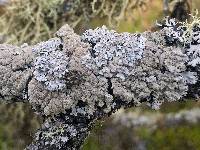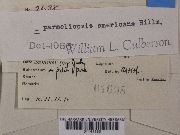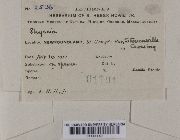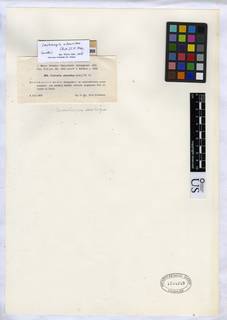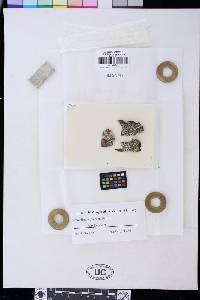
Consortium of Lichen Herbaria
- building a Global Consortium of Bryophytes and Lichens as keystones of cryptobiotic communities -
- Home
- Search
- Images
- Species Checklists
- US States: O-Z >
- US National Parks
- Central America
- South America
- US National Parks
- Southern Subpolar Region
|
|
|
|
Family: Parmeliaceae
Salted Starburst Lichen
[Cetraria aleurites (Ach.) Th. Fr., moreImbricaria aleurites (Ach.) DC., Imshaugia aleurites f. vulnerata (Hillmann) S.Y. Kondr., Lichen aleurites Ach., Lobaria pallescens Hoffm., Parmelia aleurites (Ach.) Ach., Parmelia aleurites var. aleurites Nyl., Parmelia aleurites var. diffusa (Weber) Ach., Parmeliopsis aleurites (Ach.) Nyl., Parmeliopsis aleurites f. aleurites (Ach.) Nyl., Parmeliopsis aleurites f. diffusa (Weber) Grummann, Parmeliopsis aleurites f. eualbescens Maas Geest., Parmeliopsis aleurites f. obsessa (Ach.) Gyeln., Parmeliopsis aleurites f. pityreiformis (Hillmann) Gyeln., Parmeliopsis aleurites f. vulnerata (Hillmann) Gyeln., Parmeliopsis aleurites var. albescens (Wahlenb.) Maas Geest., Parmeliopsis aleurites var. albidula (Gyeln.) Gyeln., Parmeliopsis aleurites var. aleurites (Ach.) Nyl., Parmeliopsis aleurites var. pityreiformis (Hillmann) Grummann, Parmeliopsis aleurites var. roseola (Gyeln.) Gyeln., Parmeliopsis aleurites var. vulnerata (Hillmann) Maas Geest., Parmeliopsis pallescens (Hoffm.) Hillmann, Parmeliopsis pallescens f. angustifolia (Hillmann) Gyeln., Parmeliopsis pallescens f. diffusa (Weber) Hillmann, Parmeliopsis pallescens f. pallescens (Hoffm.) Hillmann, Parmeliopsis pallescens f. subalpina (Räsänen) Zahlbr., Parmeliopsis pallescens f. vulnerata (Hillmann) Rass., Parmeliopsis pallescens var. albosorediata Gyeln., Parmeliopsis pallescens var. angustata Gyeln., Parmeliopsis pallescens var. angustifolia (Hillmann) Zahlbr., Parmeliopsis pallescens var. fuscisorediata Gyeln., Parmeliopsis pallescens var. pallescens (Hoffm.) Hillmann, Parmeliopsis pallescens var. pityreiformis Hillmann, Parmeliopsis pallescens var. vulnerata Hillmann, Squamaria aleurites (Ach.) Nyl.] |
Nash, T.H., Ryan, B.D., Gries, C., Bungartz, F., (eds.) 2002. Lichen Flora of the Greater Sonoran Desert Region. Vol 1. Thallus: foliose, adnate to loosely adnate, appressed, orbicular, (2-) 3-8 (-12) cm diam., often rather randomly arranged lobes: usually 1-4 mm long, 0.5-1.5 mm broad, flat, linear to sublinear, divergent to contiguous or crowded and overlapping, sometimes quite dissected, irregularly (± pinnately) branched, tips rounded, often forked upper surface: whitish mineral gray, light gray or bluish gray, or in some thalli becoming darker and distinctly greenish or brownish, sometimes wrinkled or shallowly pitted in older parts, continuous to faintly rimulose; lobe tips shiny, becoming rough with incipient isidia isidia: laminal, abundant, cylindrical, simple to branched, to c. 2 mm tall, usually with warty tips, grayish- or yellowish-brown, to brown-black and shiny at tips, often breaking, rarely becoming granulose and coalescing to form a paler gray or greenish sorediate-isidiate mass medulla: white; algal layer with Trebouxia lower surface: white to cream-color or pale brownish, somewhat wrinkled; rhizines: sparse to dense, brownish or darkening, simple, c. 0.5-1 mm long, sometimes short and wart-like Apothecia: occasional, 2-7 mm diam., flat, saucer-shaped, adnate; disc: pale gray or brownish or reddish brown, dull, epruinose; thalloid margin persistent, entire or breaking up into isidia ascospores: ellipsoid, (5-) 6 (-9) x (3.5-) 4 (-6) micrometer Pycnidia: rare, small, black, at or near margins of lobes, up to 0.1 mm diam. conidia: 3-4 x 1 micrometer Spot tests: upper cortex and medulla K+ deep yellow, C-, KC-, P+ deep yellow, orange, or reddish, UV- Secondary metabolites: upper cortex with atranorin and chloroatranorin; medulla with thamnolic acid (major) and decarboxythamnolic acid (trace). Substrate and ecology: on bark of conifers and on dead stumps in open pine-oak woodlands and mixed conifer forests, sometimes in ravines or near streams, occasionally on broad-leaved trees and shrubs, sometimes on old wood, rarely on rocks World distribution: circumpolar, boreal, montane; in North America, Europe, Asia, Australasia Sonoran distribution: Arizona, Chihuahua, Sonora and Sinaloa, at 1300-3000 m. Notes: Somewhat similar species include Parmelinopsis minarum and P. horrescens, both of which have dark lower surfaces and sparse cilia, Heterodermia granulifera, which has a dull, fibrous upper surface, pustular isidia, and a K+ red medulla, and Myelochroa obsessa, which has a pale yellowish medulla and sparse cilia. All of these species have different secondary metabolite profiles from either Imshaugia species. |
|
|
|
Powered by Symbiota



